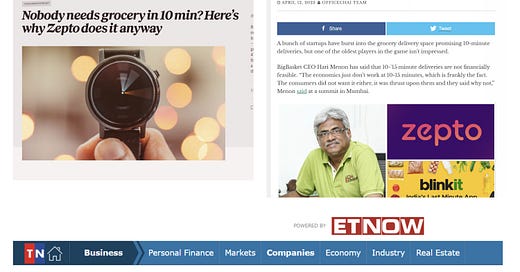Why Contrarian Ideas Win Big
Successful start-ups usually envision a future or a product so different, it looks absurd… until it isn’t
The most transformative breakthroughs don’t come from playing it safe. They start as whispers of the impossible, often dismissed as crazy, impractical, or outright delusional. But within those bold, outlandish ideas lies the power to upend industries, rewrite the rules, and achieve revolutionary change.
While most people say, “It won’t work,” the contrarian asks, “What if it could?” And when they’re right, the payoff isn’t incremental – it’s exponential.
1. Zepto: The 10-Minute Grocery Dash That Defied Logic
Quick commerce is now everywhere in Urban India. Zepto, Blinkit, Instamart– they’ve reshaped how we shop, eating into market share from traditional retailers and even behemoths like Amazon. Billions have poured into the sector, cementing its place as the future of shopping.
But go back to 2021, and the idea of 10-minute grocery delivery was laughable. Who even needs that? Critics lined up with a checklist of impossibilities:
Logistics? Insurmountable.
Economics? Unsustainable.
Demand? Unproven.
It looked like a classic case of burning VC money to deliver a box of milk faster.
Zepto thought differently. They understood that time was the unspoken currency of modern life. Speed wasn’t a luxury—it was the product. By perfecting logistics through dark stores and tech-driven optimization, they made the ridiculous a reality. They didn’t just deliver groceries; they delivered time.
What seemed absurd became inevitable. And suddenly, 30-minute delivery felt slow.
The secret sauce needed to make quick commerce a success- India being the only country where this is the case- was finally here.
2. SpaceX: From Laughing Stock to Space Pioneer
In the early 2000s, space was a club where only governments got to play. NASA, ESA, and Roscosmos monopolized the skies. So when Elon Musk rolled out his plan for reusable rockets and low-cost space travel, the reaction was almost comical.
Experts scoffed. "Rockets aren't toys," they said. The idea of a private company succeeding in space exploration? Ludicrous.
And, for a while, the skeptics seemed right. SpaceX’s first three launches failed. Explosions. Losses. Mockery.
But Musk’s contrarian conviction was relentless: space travel must get cheaper, and reusable rockets are the way. In 2008, the fourth Falcon 1 launch finally succeeded. That single moment shifted space history.
Today:
SpaceX is the leader in commercial space.
NASA relies on them for missions.
Starlink is revolutionizing internet access.
Reusable rockets are the new standard.
SpaceX didn’t just join the space race; they rewrote the rulebook.
3. AI “Wrappers”: The Unsung Heroes of the AI Revolution
Everyone remembers the ‘Chat GPT’ moment
“Industries will be re-written.”
“Millions of jobs will be lost."
“The real value is in the models,” the experts proclaimed.
Applications built on top of these models? Dismissed as “wrappers”—nice interfaces, but insignificant.
Fast forward, and the narrative has flipped. The foundational models remain critical, but the biggest value is being captured by companies applying these models to solve real problems.
Examples?
Perplexity An LLM wrapper, is redefining how people search and learn about new things. Who would've thought you could actually beat google at it's own game?
100s of Vertical AI systems combining domain specific knowledge + AIs
These “wrappers” are no longer just superficial layers. They’re the bridge between cutting-edge AI and human needs. Think back to the smartphone era—the real explosion happened when developers built apps that unlocked the device’s potential. That’s what AI wrappers are doing today.
Vertical AI Agents Could Be 10X Bigger Than SaaS - Y Combinator
So what do Zepto, SpaceX, and even AI wrappers such as Perplexity have in common?
They dared to challenge assumptions so deeply entrenched they seemed unquestionable. They asked "What if?" when everyone else was certain it couldn’t be done.
Where others saw impossibilities, they saw opportunities- creating enormous value in the process.
Looking Ahead: Where Are Today’s Contrarian Bets?
The true contrarian bet isn’t just about solving hard problems; it’s about seeing the world differently.
It’s about envisioning a future or a product so different it looks absurd… until it isn’t.
My prediction for 2025
We’ll see a wave of digital products built from the ground up with generative AI at their core—introducing radically different user interfaces and experiences than we have today. While hardware pioneers like Rabbit R1 and Humane AI have already begun reimagining devices, their impact has been mixed because the supporting digital infrastructure isn’t fully mature and the behavioral shift with a new hardware takes time.
As natural interaction methods like voice and text become standard, opportunities will arise to challenge even the most entrenched players, from platforms like LinkedIn to the way we browse the web. The real winners in this space will be those that harness generative AI to deliver seamlessly integrated, hyper-personalized, and effortlessly consumable products.
Today, everyone seems eager to tack AI assistants or “co-pilots” onto existing platforms. Yet truly seamless integration calls for a fundamental redesign—something far easier for newcomers to achieve than for established incumbents. Just as Figma disrupted Adobe, a new generation of AI-first platforms is poised to do the same across multiple sectors.
It might sound a impossible, but this future is closer than you think.
So, what’s a truly contrarian idea you believe in that no one else sees coming?
Subscribe now to receive such posts directly to your inbox whenever they’re out!




